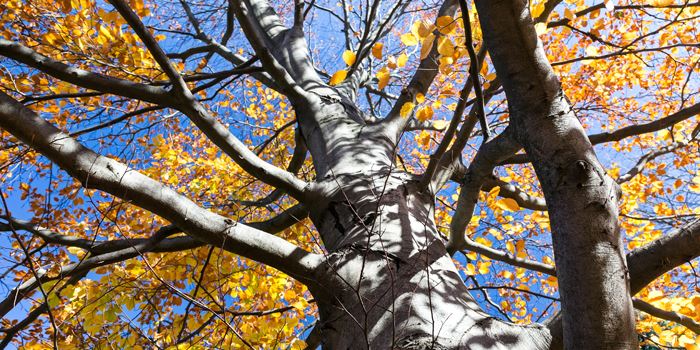The Essence of Marcescence

By Karen Menard
To fall or not to fall? That is the question. For some deciduous trees, the arrival of “fall” doesn’t necessarily mean that leaves will be cast. Types such as pin oaks (Quercus palustris) or young American beech (Fagus grandifolia) don’t always shed their leaves right away.
Some species of oak and young beech trees are “winter marcescent,” meaning they lack the enzyme production responsible for developing the abscission layer that lies at the base of the leaf. This layer is essential for easily releasing the leaf onto the forest floor during the autumn months. Without this, the papery orange-brown leaves of some oaks and young beeches are left hanging on throughout the winter, rattling in the wind.
There are some theories as to why this phenomenon occurs. One has to do with the thought that if dried leaves pose a noisy obstacle to herbivores like deer and the twigs appear less tasty, the animals will be discouraged from feeding.
Another possibility is that delayed decomposition, dropping leaves during spring especially at dry, less fertile sites, provide the tree adequate nutrients at its most needed time. Leaves having more time on the limb and exposed to air and sunlight longer would be subject to increased photodegradation, a process that would enable them quicker decomposition once shed.
Whatever the reason, leaves suspended in the essence of a glittering layer of frost at sunrise are always a welcome winter sight while walking a trail.
Object reference not set to an instance of an object.
The best Metroparks sites to see uncommon American beech trees include Secor, along the main park drive and around the Meadowview and Lone Oak parking areas, as well as some areas of Pearson. In addition to their dried orange leaves, beech trees can easily be identified in a fall or winter woods by their smooth, gray bark resembling an elephant leg.
If you are on the lookout for pin oaks, which are most often found in the wet prairies and flatwood plant communities of the Oak Openings Region, visit Wiregrass Lake Metropark, Oak Openings Preserve or Irwin Prairie State Nature Preserve. These tall species can be easily identified by their pointed leaves and the bare, lower branches that hang downward.
As you take your late fall and winter hikes this season, listen closely for the soft clapping of the oak or beech leaves and appreciate them for their icy sparkle as they wave in a new season.
Did you know?
Beech nuts are 50 percent fat and 20 percent protein. They were the number one food choice of the now extinct Passenger pigeon. One bird could consume a half pint of beech nuts daily.
--
Photos - Top: American beech. Above: Pin oak